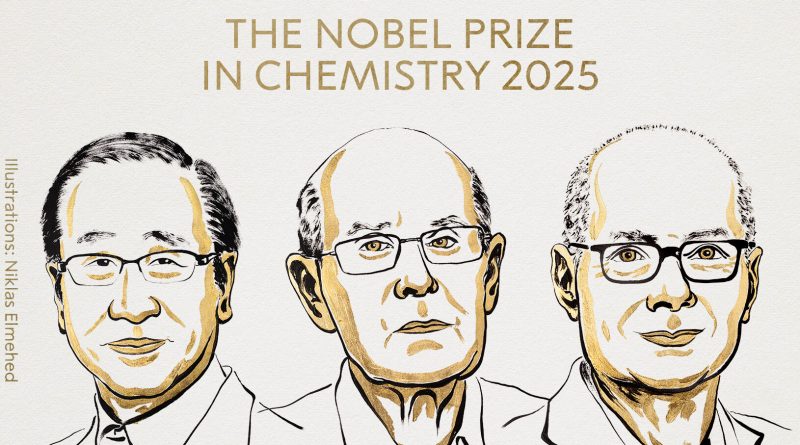Three Scientists Win 2025 Nobel Prize in chemistry for creating molecular frameworks
Three scientists have been awarded the 2025 Nobel Prize in Chemistry for the development of metal–organic frameworks.
Announcing the award on its website on Wednesday, the Royal Swedish Academy of Sciences said the trio developed “molecular constructions with large spaces through which gases and other chemicals can flow.”
The Academy said the constructions and metal-organic frameworks can be used to harvest water from desert air, capture carbon dioxide, store toxic gases, or catalyse chemical reactions.
The laureates are Susumu Kitagawa, a professor from Kyoto University, Japan, Richard Robson, a Professor at University of Melbourne, Australia and Omar Yaghi, a Professor at University of California, Berkeley, USA.
The three got their PhD from Kyoto University, Japan (1979); University of Oxford, UK (1962); and University of Illinois Urbana-Champaign, USA (1990) respectively.
They are to share the prize amount of 11 million Swedish kronor (about $1 million) equally.
Building molecules with space inside
The Nobel Committee described the laureates’ work as a revolutionary advance in chemistry.
In the molecular structures developed by the scientists, metal ions function as cornerstones linked by long organic molecules to form porous crystals.
These materials called the Metal-organic Frameworks (MOFs) contain vast cavities that can be customised for specific uses, from environmental cleanup to industrial catalysis.
“Metal–organic frameworks have enormous potential, bringing previously unforeseen opportunities for custom-made materials with new functions,” Heiner Linke, Chair of the Nobel Committee for Chemistry.
From unstable beginnings to scientific breakthrough
The foundations of MOFs trace back to 1989, when Richard Robson experimented with positively charged copper ions and a four-armed organic molecule that could attach to them.
The Academy said the result was like a diamond filled with innumerable cavities.
However, Robson’s early construction was unstable. It took the later work of Susumu Kitagawa and Omar Yaghi to turn the fragile model into a robust and versatile material.
ALSO READ: American, French duo win 2020 Nobel Prize in Chemistry
Between 1992 and 2003, Kitagawa demonstrated that gases could flow in and out of the constructions and predicted that MOFs could be made flexible, while Yaghi created a very stable MOF and showed that it can be modified using rational design, giving it new and desirable properties.
The Academy noted that since their discoveries, chemists have created tens of thousands of different MOFs.
“Some of these may contribute to solving some of humankind’s greatest challenges, with applications that include separating PFAS from water, breaking down traces of pharmaceuticals in the environment, capturing carbon dioxide or harvesting water from desert air.”
About the Nobel Prize in Chemistry
The Nobel Prize in Chemistry, awarded annually by the Royal Swedish Academy of Sciences since 1901, recognises outstanding contributions to the field.
The Academy, founded in 1739, is an independent organisation dedicated to advancing the natural sciences and mathematics and promoting their impact on society.


